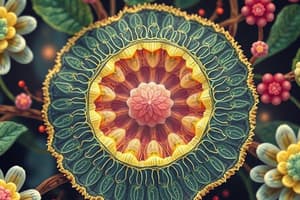Podcast
Questions and Answers
What is a primary function of the central vacuole in plant cells?
What is a primary function of the central vacuole in plant cells?
- Facilitating photosynthesis
- Converting light energy into chemical energy
- Stockpiling proteins and inorganic ions (correct)
- Synthesizing ATP
Which organelle is primarily responsible for cellular respiration in plant cells?
Which organelle is primarily responsible for cellular respiration in plant cells?
- Vacuole
- Nucleus
- Chloroplast
- Mitochondrion (correct)
What are thylakoids responsible for in chloroplasts?
What are thylakoids responsible for in chloroplasts?
- Maintaining cell structure
- Storing excess energy
- Generating ATP from glucose
- Photosynthesis and light absorption (correct)
How does the cytoskeleton contribute to cellular activities in plant cells?
How does the cytoskeleton contribute to cellular activities in plant cells?
What connects adjacent grana in chloroplasts?
What connects adjacent grana in chloroplasts?
What is the primary function of the nucleolus within the nucleus?
What is the primary function of the nucleolus within the nucleus?
What is the main difference between Rough ER and Smooth ER?
What is the main difference between Rough ER and Smooth ER?
Which statement about the Golgi apparatus is true?
Which statement about the Golgi apparatus is true?
What is the composition of the membranes in eukaryotic cells primarily accounted for by?
What is the composition of the membranes in eukaryotic cells primarily accounted for by?
Which cellular structure is considered a major site for lipid synthesis?
Which cellular structure is considered a major site for lipid synthesis?
How are ribosomal subunits formed?
How are ribosomal subunits formed?
What role does the tonoplast play in plant cells?
What role does the tonoplast play in plant cells?
What is primarily synthesized in the nucleus to facilitate protein synthesis?
What is primarily synthesized in the nucleus to facilitate protein synthesis?
What is a key function of the cell wall in plant cells?
What is a key function of the cell wall in plant cells?
What are the two main types of proteins associated with the lipid bilayer of biological membranes?
What are the two main types of proteins associated with the lipid bilayer of biological membranes?
Which component is not part of the structure of a mature plant cell wall?
Which component is not part of the structure of a mature plant cell wall?
What basic organization characterizes all biological membranes, including those in plant cells?
What basic organization characterizes all biological membranes, including those in plant cells?
What type of cells make up plants?
What type of cells make up plants?
How do the internal membranes in eukaryotic cells contribute to cellular functions?
How do the internal membranes in eukaryotic cells contribute to cellular functions?
What term describes the model that explains the structure of biological membranes?
What term describes the model that explains the structure of biological membranes?
Why do plant cells have a specialized structure compared to other life forms?
Why do plant cells have a specialized structure compared to other life forms?
Study Notes
Plant Cell Overview
- Composed of eukaryotic cells, consisting of millions of specialized cells.
- Exhibits a complex division of labor through various cell types, tissues, and organs.
Cell Wall
- Provides protection, maintains shape, and regulates water intake.
- Supports plant structures against gravitational forces.
- Composed of cellulose microfibrils in a matrix of proteins and polysaccharides.
- Contains a primary cell wall, middle lamella with sticky polysaccharides, and layers of a secondary cell wall.
Biological Membranes
- Plasma membrane, or plasmalemma, forms the outer boundary of cells, regulating substance movement.
- Comprised of phospholipid bilayers with integral and peripheral proteins as per the fluid-mosaic model.
- Extensive internal membranes in eukaryotic cells partition functions and participate in metabolism.
The Nucleus
- Houses the cell's genetic material and regulates growth, metabolism, and differentiation.
- Contains nucleolus where ribosomal RNA is synthesized and combined with cytoplasmic proteins to form ribosomal subunits.
- Messenger RNA (mRNA) synthesized in the nucleus directs protein synthesis by translating genetic information into polypeptides.
Endoplasmic Reticulum (ER)
- Consists of a network of internal membranes; accounts for half the cell's membranes.
- Smooth ER lacks ribosomes; involved in lipid synthesis and membrane assembly.
- Rough ER covered with ribosomes; specializes in protein synthesis and processes polypeptides into glycoproteins.
Golgi Apparatus
- Appears as a stack of 3-10 flattened membrane sacs.
- Processes and distributes secretory products, including proteins and polysaccharides destined for secretion.
Central Vacuole
- Surrounded by a selective membrane called tonoplast; regulates solute transport.
- Functions: stockpiling proteins and inorganic ions, storing metabolic byproducts, pigments, and defensive compounds.
- Increases the surface-to-volume ratio of cells.
Mitochondria & Chloroplasts
- Both contain double membranes and are critical for energy conversion.
- Mitochondria are the sites of cellular respiration, converting sugar metabolism into ATP.
- Chloroplasts contain chlorophyll, facilitating photosynthesis, and house thylakoids that form grana; stroma surrounds thylakoids.
Cytoskeleton
- A fibrous network that organizes the cell's structures and activities.
- Involves actin-myosin interactions and sol-gel transformations that promote cytoplasmic streaming for efficient material distribution.
Studying That Suits You
Use AI to generate personalized quizzes and flashcards to suit your learning preferences.
Related Documents
Description
Explore the fascinating world of plant cells and discover their unique structures and functions. This quiz covers the properties of eukaryotic cells, the various types of plant tissues, and the specialized functions that contribute to plant life. Test your knowledge and learn more about how plants operate at a cellular level!




